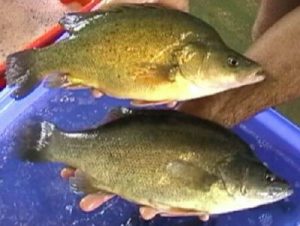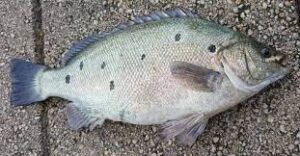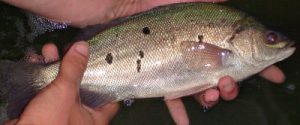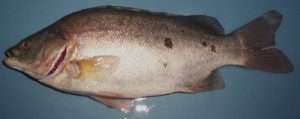Jade Perch
Warning ! Jade Perch can NOT be stocked in farm dams unless your dam is in the Barcoo River Basin. Minimum order 30 fish
Jade Perch, originate from the Barcoo River in Central Australia. Aussie Fish Aquatics regularly collects wild fish, under permit, to use in a genetic improvement program. Our genetic improvement program has been ongoing, continuously, for over 30 years.


There are a number of “Scortum” species in Australia, however it has become apparent that only the one from the Barcoo River is suitable for the table. Other river systems have fish that look the same, (See picture below of a Scortum Hillii from the Fitzroy/Dawson River Basin.) but are described by local people as “The Leathery Grunter.”
Scortum Hillii are not considered suitable for the table.
Only fingerlings produced from stock originating from the Barcoo River should be used for aquaculture purposes.
Aussie Fish Aquatics is arguably the largest producer of Jade Perch fry and fingerlings.
AFQ is AQIS approved and Government health certified.
We ship to all mainland States of Australia, although they are not permitted in Western Australia, and we export to almost anywhere.
Aussie Fish Aquatics export hundreds of thousands of Jade Perch fry each season.
Jade Perch is a new species to the developing freshwater fin-fish grow-out sector. Over the last few years, this species has been tried by a few people in recirculating systems, and a hand-full of pond farmers. These pioneering growers found the Jade Perch growing qualities to be excellent. Early results attracted the attentions of some of Queensland’s larger growers who have now tried these fish in their large ponds with some great results. Jade Perch seem to grow out considerably faster than Silver Perch. Some growers have even said, twice as fast.
Jade Perch don’t do well in cooler weather. The feeding behaviour of Jade Perch is normally vigorous in the extreme. The fish race towards the end of the pond where the approaching farmer is about to feed, creating quite a bow wave as they begin to break the surface with their heads. Once they reach the edge of the pond they will extend their entire head from the water in anticipation of a feed.
This behaviour decreases in intensity as the temperature drops. We are told by growers, that under 18C the surface feeding will almost stop. Some farmers have experienced stock losses during winter. At AFQ we were able to harvest fingerlings in water temperatures around 14-15C without losses. The difficulties experienced during winter by the early growers, have been overcome through our management practices.
Growers in warmer parts of Australia, especially far north Queensland, should not face these problems at all. It should be noted that Jade Perch are very well suited to grow-out in recirculating systems. They make an excellent beginner’s species, and are ideal for aquaponics.
Pond grown fish have large quantities of fat within their body cavity.
This fat is also present in pond grown Silver Perch, however Jade Perch have a little more of this fat. Anglers who have caught and eaten these fish from the Barcoo River also report seeing a large “lump” of fat in the gut of the fish. The fish comes from a very hostile environment. Fish in Australian rivers cope well with the “feast and famine” nature of the river systems in this country. After flooding the natural food supply for these fish is abundant. This glut of food is a contrast in the extreme compared to a drought situation where the fish will find getting a feed very difficult. Also during winter (Queensland’s dry season) the fish are relatively inactive and probably rarely feed.
The stored fat will be used to help the fish survive in these situations. In aquaculture, fish are grown in an artificial environment such as a commercial fish pond or a recirculating system. They are in fact being kept in a “feast” situation. The fish grow rapidly and store fat as quick as they can, to be ready for the “famine”, which never comes. If your market finds this fat undesirable, perhaps a low protein, low fat, diet and a reduction in food will reduce the level of fat produced by your crop of fish.
It is our belief that a reduction in the frequency of feeds will also help. Reducing the food while the temperature is high should result in the fish burning up its fat reserves. Probably the optimal temperature for growing this fish is around 27C. Once the fish reaches your desired market weight try keeping the temperature up while reducing the feed intake. For every 10 degrees Centigrade the fishes metabolic rate is doubled. Therefore they burn up energy at twice the rate. You should also be aware that the fishes need for oxygen is also doubled.
The Jade Perch will grow on a wide variety of diets. Omega-3 content of the flesh varies with the diet used.
Jade Perch and their spots
Jade Perch are well known for their black spotting. These spots vairy from fish to fish. Some fish have many spots, some have only a few, or none at all. The spots can be any size and in any position on the fish. Each side of an individual fish will be different.
See the pictures below showing many individual fish and their spots.


Silver Perch
Silver perch may be stocked in farm dams in the Auburn, Barambah, Bremer, Brisbane, Boyne, Burnett, Burrum, Caboolture, Dawson, Eliot, Fitzroy, Kolan, Lockyer, Logan, Maroochy, Mary, Nogoa, Nogo, North Pine, Stanley, South Coast, and South Pine river basins. Silver perch are also good for aquaponics.
Silver perch have been farmed commercially for decades. They are an ideal fish for growing in ponds and raceways. They will also grow in tanks, however some tank systems do not produce perfect results. For reasons not fully understood, some tank systems seem to result in a growth barrier at about 300-350 grams. For hobby backyard aquaponic systems this probably won’t be a problem as 350 grams is still a good plate size whole fish. Back in 1916 silver perch were seen as a candidates for aquaculture. In the early 1980’s commercial production was trialled by the pioneers of a now well established industry. The species is now grown commercially in many countries around the world. The species is most popular in Asian countries. They have the potential to grow to about 6-8 kilo. (Depending on which scientist you spaek to.)
This is an Australian native species from the Murray Darling River Basin. This is the largest river basin in Australia, covering a very large inland area of Australia with a broad climate range. Parts of the basin are quite arid. Temperature ranges are broad and water chemistry varies considerably. This all adds up to a sturdy fish that is not too demanding on the grower. Best results are achieved at optimum temperatures and water quality. A temperature range between 23C and 28C is best, but they will tolerate as low as *2C and as high as 37C. (*Fisheries Action Program Australian Department of Environment 2002.)
Professional growers achieve 600 to 800 grams in less than 18 months. They grow on a range of commercial diets, with a wide range of fat and protein contents. Silver perch are known to have very high levels of beneficial omega-3. Research has shown they have one of the highest levels of omega-3 in seafood tested by the CSIRO. Click for details. It is noteworthy that the omega-3 content of the flesh will vairy according the died used to grow the fish. This means they not only are an excellent table fish, but they are also very healthy to eat !
FOR THE FARM DAM
Silver Perch are omnivorous and will thrive in most farm dams. They will eat worms and most other aquatic life including weeds. Should you add fingerlings in the future the older fish are very unlikely to eat the new fingerlings. They readily take artificial food, such as aquaculture pellets, chook pellets or bread. Bread or chook foods are not the best of diets for fish but will do in small quantities. Aquaculture pellets are a properly balanced diet and fish will thrive on these commercially available foods. As the Silver Perch soon come to know when they will be fed, they will be ready and waiting near the surface at feeding time. We recommend Silver Perch be fed during the late evening. If they are fed early in the morning there is a risk that birds may eat your fish before you are up and about, especially in summer when it is light very early. (Remember the fish will be congregating in one spot waiting to be fed.) Feeding Silver Perch just before sunset will provide a spectacular display for your friends and visitors. A great talking point for a barbie.
Silver Perch can be stocked at about 300-400 per hectare if they are not fed, and up to 1000 per hectare if their food is to be supplemented artificially. Silver Perch that have been fed are very easy to catch, just add a hook to their food!? Otherwise use worms fished on the bottom with a very light float. Silver Perch are excellent eating but can sometimes have a weedy or muddy flavour. It is best to hold live fish in very clean water for a week if the flavour is not pleasant. Alternatively, only take fish for eating from your dam during dry spells when there is no run-off into the dam, and water is clear.
Silver Perch are now produced on large fish-farms for the restaurant trade. They are well known for their delicate melt-in-the-mouth texture. They also have one of the highest omega-3 levels of over 200 sea-foods tested by the CSIRO.
Australian Golden Perch
Australia’s Golden Perch have been popular as a table fish for generations. Until recently licenses existed for the commercial harvest of golden perch from the Murray River. This practice has been discontinued, with the possible exception of a few licences at the mouth of the Murray River. Almost all golden perch now come from aquaculture. Early in 2004 the first commercial quantities of Lake Eyre strain fingerlings were supplied to grow-out farms. There are three major strains of golden perch. These strains have distinct qualities and perform differently under aquaculture conditions. Aussie Fish Aquatics produces the Murray/Darling strain for dam stocking, and the Lake Eyre strain for aquaculture grow-out.
There are three distinct strains of golden perch. The Murray/Darling River system (Macquaria ambigua ambigua), the Lake Eyre Drainage System (Macquaria ambigua ssp.), and the Fitzroy/Dawson River System, (Macquaria ambigua oriens). The largest is the Murray Darling System which extends over four states. Starting in Queensland moving through New South Wales and Victoria and finally reaching the sea in South Australia. The Lake Eyre System also drains from Queensland to South Australia where it empties into Lake Eyre and finally just dries up! The Fitzroy Dawson River system is limited to Queensland. It drains a large portion of Central Queensland and empties into the sea at Rockhampton. There has been some debate over which of these strains of golden perch may be best for aquaculture. Some say the colour is the most important factor and that one strain or the other displays the most “gold” colour. Aussie Fish Aquatics has kept all three strains over the years and our experience is that all strains will display good gold colour when kept in the right conditions.
The first commercial supplies of golden perch fingerlings were supplied to grow-out farms in Australia during the 2003-4 season. They were from the Lake Eyre strain. These fish have shown excellent growth. One grower reports that they grow much faster than silver perch. This grower is using large round polly tanks. In his words the fish are described as “..the Barramundi of the inland..”.
After 40 days the fish had grown from about 1gm to an average size of 25gm. The fish were graded into three average sizes, 50gm, 24gm and 12gm. One fish was 112gms.
After 75 days they are estimated to be an average of 40-50 gm. This is an estimate as the water temperature was 14-15C, and handling was considered an unnecessary risk at this relative low temperature. This grower says they eat actively at 15C, and at 12C still feed but not so eagerly. This contrasts with Silver Perch which cannot be seen feeding at 14C on the same farm.
After 100 days the average of the larger fish was 108gms. The largest fish was now just over 200gms. The average of the fish in the medium size range, (which is now two thirds of the population) is 80gms. The grower reports that they have gone from 20gms to 80gms in only two months! The FCR, (food conversion rate) over the range of sizes is between .8 and 1.7 to 1 This is using dry food.
They are a little more difficult to handle. The fish have smaller scales and are softer to the touch. When handled for grading or other management tasks, extra care should be taken not to cause any physical damage to the fish as they may become infected. Using graders with metal bars seem to be damaging to these fish. Some improvement has been achieved by increasing the oxygen before handling.
It should be noted that the variety of golden perch used for the weaning trials were not from the Lake Eyre River System. The Lake Eyre variety of fingerlings were not available for these trials. The Lake Eyre variety is from the same river system as the Jade Perch. Jade Perch are extraordinary performers in aquaculture. It is believed that the golden perch from this river system will also be better in aquaculture that other strains. The weaning of this season’s fingerlings proved to be much easier than other strains.
Golden perch is a native Australian fish. It is marketed as callop or yellowfin perch. The market was supplied by wild caught fish, however almost all these licences and permits to harvest these fish from the wild have been discontinued. When the fish were available from wild harvest, Gilled and gutted fish 500g to 1 kg, (up to 4 kg) sold for AUD9-16 per kg at Sydney fish markets. Quantities sold annually varied greatly. Sydney fish market figures were 200 tonnes cleared on the auction floor in 1993, and 4 tonnes in the first half of 1996. Market analysts believe that the total quantity sold in Sydney and Melbourne were at least four times that sold on the Sydney fish market. This indicates that the domestic market can accept large quantities (ie 800 tonnes) of the product.
 Request a Quote!
Request a Quote!
